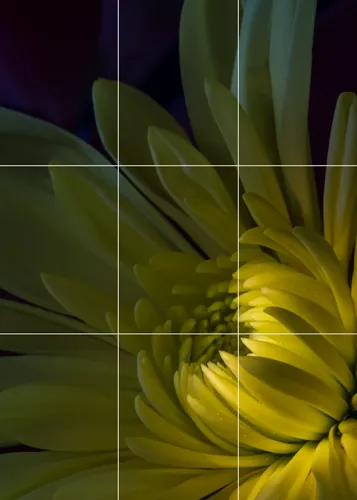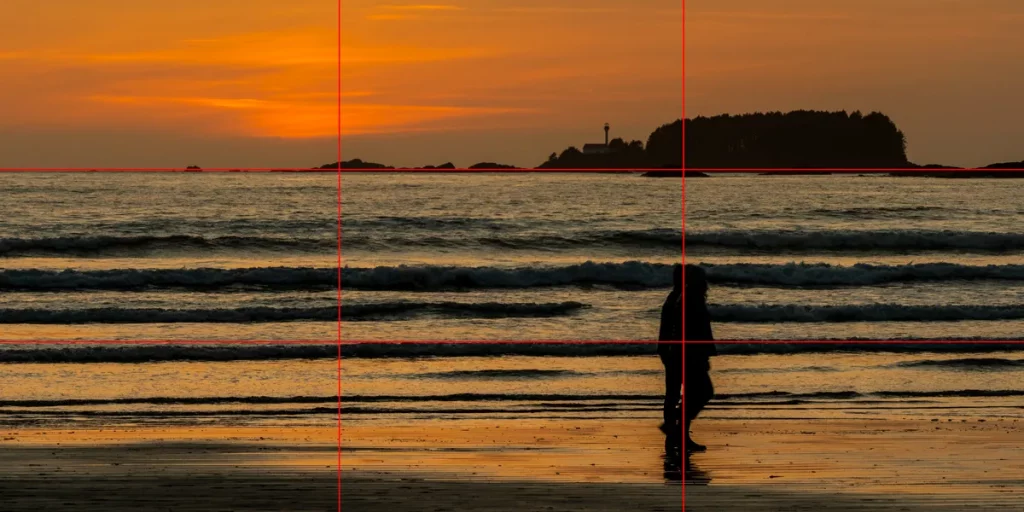
Photography as a Hobby for Beginners: Unlock Your Artistic Vision
Photography can be a fulfilling and enjoyable hobby that brings a creative outlet to your


The rule of thirds for photography is an important tool in any photographer’s kit.
Everywhere you look, photographers are using this simple composition technique to create beautiful images with a distinctive perspective and compelling storytelling qualities.
To use it effectively, you have to do more than follow these guidelines. You need to understand the rule and when to break it.
The rule of thirds in photography is a compositional rule that states that photos are more aesthetically pleasing when key elements are placed along the grid lines or two-thirds marks. It creates a sense of balance and encourages viewers to explore the image. Compositions with key elements in the centre of the frame are less dynamic and often look unfinished.
One way to create an effective photographic composition is by thinking of it in terms of crosses. When shooting a subject, ensure there is enough negative space around the subject, so it is balanced with your photo.
The basic premise is to divide the photo into nine equal parts, then position the most important elements in your scene along the lines or intersections.
Wanting a more dynamic and visually interesting photo, applying the rule of thirds, can be a great place to start.
The rule of thirds also encourages dynamism in photography compositions. You see something off-center, your eyes, then take you on a journey through the rest of the image. This adds interest to photos and makes them more visually appealing.
By emphasizing intersections rather than the centre point in an image, viewers are encouraged to explore all aspects of the photograph
The rule of thirds is a great way to add interest to your photos and make them more visually appealing.
The Rule of Thirds, which was first mentioned by John Thomas Smith in 1797. His book Remarks on Rural Scenery has grown to be the most widely used compositional principle in photography.
Divide your image into nine equal pieces using the Rule of Thirds explained in photography publications and textbooks. It is taught in every respectable starting photography class.
Rule of Thirds isn’t just a made-up new rule. It’s history dates back centuries (18th century) with painters during their compositions. However, the term “Rule of Thirds” wasn’t coined until much later, with credit often given to John Thomas Smith’s book Remarks on Rural Scenery (1797). In it, he described how artists should divide their canvas into thirds horizontally and vertically to create balance and interest in their compositions.
Fast-forward to the early days of photography, where photographers adopted this principle as well. With advancements in camera technology allowing for faster shutter speeds and more accurate focusing mechanisms, photographers began experimenting with different ways to compose their shots.
Soon enough, the Rule of Thirds became a staple technique taught in photography classes around the world. Today, nearly every photographer incorporates this rule into some aspect of their work – whether they’re shooting landscapes or portraits.
The Rule of Thirds is an important tool for photographers today. It helps to capture balanced and captivating images, despite being rooted in painting techniques from centuries ago.
The rule of thirds is a photographic guideline that suggests dividing the image into thirds horizontally and vertically. The idea is to keep the subject out of the middle of the frame.
The theory is that by placing points of interest in these intersections or along the lines, your photo will be more balanced and appealing to the eye.
The rule of thirds is a compositional guideline that states. A photograph should be divided into thirds by placing one line 1/3 from the top of the frame, another 1/3 from the bottom of the frame. Do the same for the left and right sides. Dividing the photo into 9 equal parts.
The premise is simple: Instead of placing your subject in the centre of the frame, position it along one of the grid lines or at one of the four intersections where the lines intersect. This will add more visual interest and make your photo feel more balanced.
The rule of thirds is a photographic composition principle that suggests that the viewer’s gaze should be divided evenly between the two major lines of the image. This principle is often used to create a balanced composition.
The rule of thirds in photography is about balance and visual interest.
Your photo will be better balanced if major components are placed at rule of thirds intersections or grid lines. Your essential pieces add visual attention to one-third of the composition while balancing out the empty space in the other two-thirds.
Composition that includes key elements smack-dab in the centre of the frame often feels very static and boring. There’s nowhere for the viewer’s eye to wander; instead, they see the subject at its centre, then leave.
However, by following the rule of thirds, a more engaging photographic experience is created where eyes tend to go to one of the intersection points rather than centre.
The rule of thirds splits a photo into 9 equal parts, with the intersections of the lines representing the 3 main parts of the image.
The rule states that you should imagine a tic-tac-toe board over your photo, with the four intersections serving as focal points. You then position your subject or elements of interest at one of those intersections or along one of the lines.
Here are a few quick tips for putting the rule of thirds into practice:
Adopting the rule of thirds can help you create more dynamic photos that engage with the viewer. But that doesn’t mean you have to apply it each and every time. As with rules, there is always a time and place to break them. The Rule of Thirds is a guideline. A way of helping you become better, pushing you to view your pictures differently, and help take perfect ones!
Here are some things to consider:
A common mistake new landscape photographers make is positioning the horizon line in the middle of the frame. This kind of image will be boring. You want to draw the viewers’ attention to something significant or that demands emphasis, and thus aligning your horizon lines along the top or bottom third can do just that.
Placing the horizontal line on the top or bottom third will highlight and draw your viewer’s eyes to what you’re trying to show them. Second, mistake is not having a straight horizon. Please ensure the horizon is straight.
This works the same for cityscape photos. Placing the building along the vertical grid lines, creates a more interesting photo for the viewer.

The rule of thirds is the most common way to apply positioning in portrait photography. We often position the subject’s within two-thirds of the frame, with their gaze along the top horizontal line. If you prefer breaking this guideline and centring a portrait, that’s okay too! Just make sure your subject’s eyes are positioned in the top third, so they’re not lost in the negative space around them. Additionally, it’s important to consider the background and negative space in your portrait photography. A cluttered or distracting background can take away from the focus of your subject. Try to find a clean and simple background or blur the background using a shallow depth of field.
Another element to consider is lighting. Natural light is often preferred for portrait photography as it can create soft and flattering shadows. However, if you’re shooting indoors or in low light situations, artificial lighting or a flash may be necessary. Experiment with different lighting setups to find what works best for your style and subject.
Lastly, don’t forget about the importance of posing and expression. Communication with your subject is key to creating a comfortable and relaxed atmosphere, which can lead to more natural and authentic poses and expressions. Encourage your subject to be themselves and have fun with the process, and be open to their ideas and suggestions.
There are a few things you can do when composing your photo. First, use an overlay in the viewfinder to help. Eventually, you’ll be able to compose photos without the overlay.
Second, use the overlay in your editing software. Especially when cropping your photos.
As with any rule, if you feel creatively motivated, don’t be afraid to break the rule of thirds. That said, the rule of thirds is practised in photography because it has been proven to be effective in creating a visually appealing photo.
Does the rule of thirds apply to all successful photographs? Absolutely not. However, photography or art has a set of fundamentals that must be understood and mastered in order to advance your skills. When it comes to developing fundamental abilities, repetition is king. Practice results in muscle memory and the development of eye trust, which eventually develops into an instinct for what in photography works and what doesn’t.
By leaving the other two thirds of the image more open by placing your topic in the left or right third of the picture. Although there are different types of composition, using the rule of thirds usually results in photos that are interesting and well-composed.
When is the rule of thirds acceptable to break? When should I deviate from the rule of thirds?
The most obvious substitution for the Rule of Thirds, which works well for many topics, is to place your subject or horizon in the centre of the image. An image is perfectly divided into two halves by a strong horizontal line at the image’s dead centre, which gives each half equal weight.

Photography can be a fulfilling and enjoyable hobby that brings a creative outlet to your

Welcome to our guide to Photoshop tutorials for beginners: A Complete Beginner’s Tutorial for Learning

Creating stunning images is all about nailing the perfect colour grade. It’s what makes your